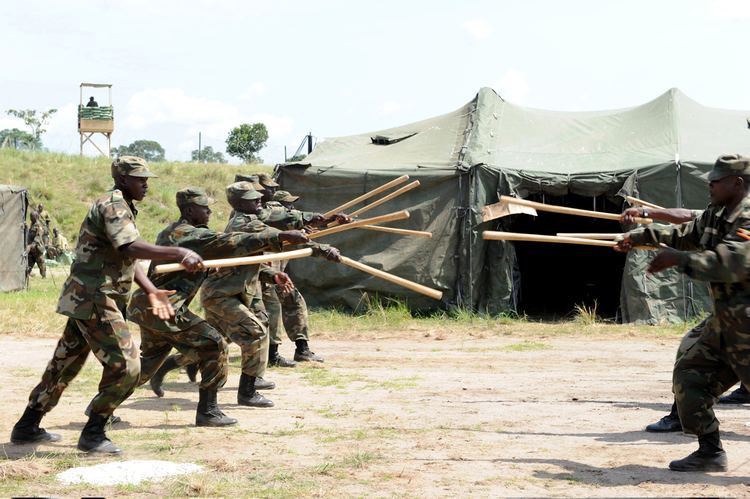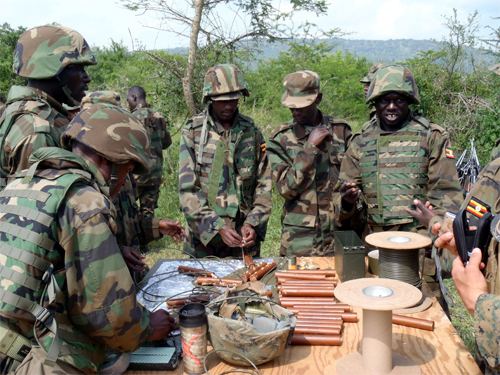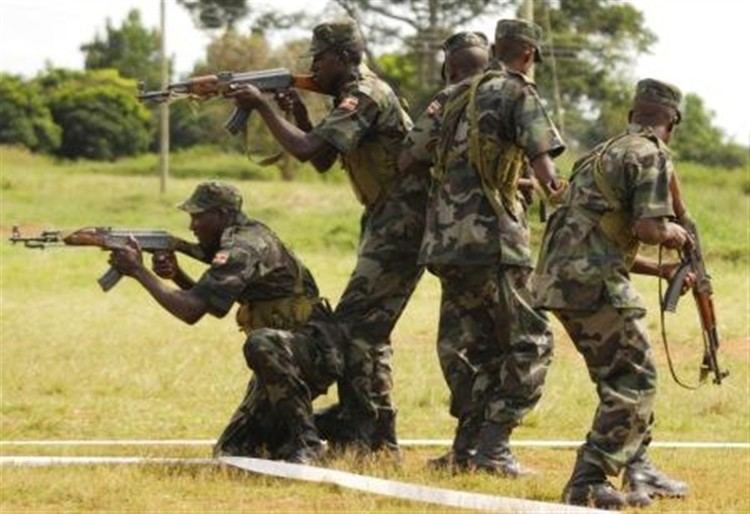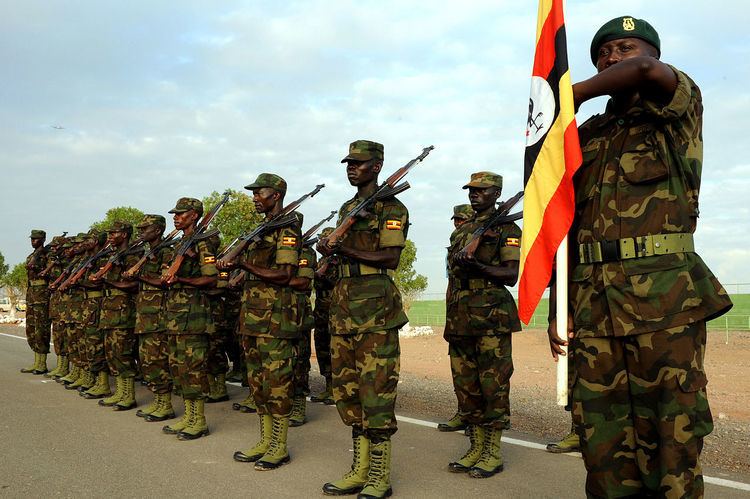Minister of Defense and Veteran Affairs Adolf Mwesige Active personnel 46,800 (2014) Minister of defense Adolf Mwesige | Military age 18 years of age | |
Service branches Land Forces, Air Force, Special Operations Command Budget USD: 933.6 million (2015) Similar Sudan People's Liberatio, Kenya Defence Forces, Rwandan Defence Forces, Armed Forces of the Demo, Tanzania People's Defence | ||
Ugandan air force ll uganda people s defence force ll jeshi la anga la uganda ll uganda military
The Uganda People's Defence Force (UPDF), previously known as the National Resistance Army, is the armed forces of Uganda. From 2007 to 2011, the International Institute for Strategic Studies estimated the UPDF had a total strength of 40,000–45,000 and consisted of land forces and an air wing.
Contents
- Ugandan air force ll uganda people s defence force ll jeshi la anga la uganda ll uganda military
- History
- 19621964
- Since 1970
- Uganda Peoples Defence Force
- African Union Mission in Somalia
- African Union Regional Task Force
- South Sudan Civil War
- Command
- Land forces
- Air forces
- Special forces
- Reserve forces
- Ministry of Defence Headquarters Mbuya
- Training schools
- Divisions
- Brigades
- Ugandan Peoples Defence Air Force
- References

After Uganda achieved independence in October 1962, British officers retained most high-level military commands. Ugandans in the rank and file claimed this policy blocked promotions and kept their salaries disproportionately low. These complaints eventually destabilized the armed forces, already weakened by ethnic divisions. Each post-independence regime expanded the size of the army, usually by recruiting from among people of one region or ethnic group, and each government employed military force to subdue political unrest.

History

The origins of the present Ugandan armed forces can be traced back to 1902, when the Uganda Battalion of the King's African Rifles was formed. Ugandan soldiers fought as part of the King's African Rifles during the First World War and Second World War. As Uganda moved toward independence, the army stepped up recruitment, and the government increased the use of the army to quell domestic unrest. The army was becoming more closely involved in politics, setting a pattern that continued after independence. In January 1960, for example, troops were deployed to Bugisu and Bukedi districts in the east to quell political violence. In the process, the soldiers killed twelve people, injured several hundred, and arrested more than 1,000. A series of similar clashes occurred between troops and demonstrators, and in March 1962 the government recognized the army's growing domestic importance by transferring control of the military to the Ministry of Home Affairs.
1962–1964

On 9 October 1962, Uganda became independent from the United Kingdom, with 4th Battalion, King's African Rifles, based at Jinja, becoming the Uganda Rifles. The traditional leader of the Baganda, Edward Mutesa, became president of Uganda. Milton Obote, a northerner and longtime opponent of autonomy for the southern kingdoms including Buganda, was prime minister. Mutesa recognized the seriousness of the rank-and-file demands for Africanising the officer corps, but he was more concerned about potential northern domination of the military, a concern that reflected the power struggle between Mutesa and Obote. Mutesa used his political power to protect the interests of his Baganda constituency, and he refused to support demands for Africanization of the officer ranks.

On 1 August 1962, the Uganda Rifles became the Uganda Army. The armed forces more than doubled, from 700 to 1,500, and the government created the 2nd Battalion stationed at the north-eastern town of Moroto on 14 November 1963. Omara-Otunnu wrote in 1987 that "a large number of men had been recruited into the Army to form this new battalion, and ... the new recruits were not given proper training" because the Army was already heavily committed in its various operations.
In January 1964, following a mutiny by Tanganyikan soldiers in protest over their own Africanisation crisis, unrest spread throughout the Uganda Army. On 22 January 1964, soldiers of the 1st Battalion in Jinja mutinied to press their demands for a pay raise and a Ugandan officer corps. They also detained their British officers, several noncommissioned officers, and Minister of Interior Felix Onama, who had arrived in Jinja to represent the government's views to the rank and file. Obote appealed for British military support, hoping to prevent the mutiny from spreading to other parts of the country. About 450 British soldiers from the 2nd Battalion, The Scots Guards and Staffordshire Regiment (elements of the 24th Infantry Brigade) responded. They surrounded the First Battalion barracks at Jinja, seized the armory, and quelled the mutiny. The government responded two days later by dismissing several hundred soldiers from the army, several of whom were subsequently detained.
Although the authorities later released many of the detained soldiers and reinstated some in the army, the mutiny marked a turning point in civil-military relations. The mutiny reinforced the army's political strength. Within weeks of the mutiny, the president's cabinet also approved a military pay raise retroactive to 1 January 1964, more than doubling the salaries of those in private to staff-sergeant ranks. Additionally, the government raised defense allocations by 400 percent. The number of Ugandan officers increased from 18 to 55. Two northerners, Shaban Opolot and Idi Amin, assumed command positions in the Uganda Rifles and later received promotions to Brigadier and commander in chief, and army chief of staff, respectively.
Following the 1964 mutiny, the government remained fearful of internal opposition. Obote moved the army headquarters approximately 87 kilometres (54 mi) from Jinja to Kampala. He also created a secret police force, the General Service Unit (GSU) to bolster security. Most GSU employees guarded government offices in and around Kampala, but some also served in overseas embassies and other locations throughout Uganda. When British training programs ended, Israel started training Uganda's army, air force, and GSU personnel. Several other countries also provided military assistance to Uganda.
Decalo writes that:
... using classic 'divide and rule' tactics, he [Obote] appointed different foreign military missions to each battalion, scrambled operational chains of command, played the police off against the army, encouraged personal infighting between his main military 'proteges' and removed from operational command of troops officers who appeared unreliable or too authoritative."
When Congolese aircraft bombed the West Nile villages of Paidha and Goli on 13 February 1965, President Obote again increased military recruitment and doubled the army's size to more than 4,500. Units established included a third battalion at Mubende, a signals squadron at Jinja, and an antiaircraft detachment. On 1 July 1965, six units were formed: a brigade reconnaissance, an army ordnance depot (seemingly located at Magamaga), a brigade signals squadron training wing, a records office, a pay and pensions office, and a Uganda army workshop.
Tensions rose in the power struggle over control of the government and the army and over the relationship between the army and the Baganda people. Shortly after February 1966, Amin was appointed Chief of the Army and Air Force Staff, while Brigadier Opolot was transferred to the Ministry of Defence as Chief of the Defence Staff. On 24 May 1966, Obote ousted Mutesa, assumed his offices of president and commander in chief, suspended the 1962 constitution, and consolidated his control over the military by eliminating several rivals. In October 1966 Opolot was dismissed from the army and detained under the emergency regulations then in force.
At about the same time, Obote abrogated the constitution, revoked Buganda's autonomous status, and instructed the Army to attack the Kabaka's palace, forcing the Kabaka to flee. Elections were cancelled. Political loyalties rather than military skill became critical amongst both officers and men. Many educated southern officers were court-martialled or dismissed in 1966 and 1967, and ethnicity became the key factor in recruitment and promotions.
Since 1970
In 1970, the International Institute for Strategic Studies (IISS) assessed the Ugandan armed forces to consist of 6,700 personnel, constituting an army of 6,250 with two brigade groups, each of two battalions, plus an independent infantry battalion, with some Ferret armoured cars, and BTR-40 and BTR-152 armoured personnel carriers, plus an air arm of 450 with 12 Fouga Magister armed jet trainers, and seven MiG-15s and MiG-17s.
In January 1971, Amin and his followers within the army seized power in a coup d'état.
Shortly after the expulsion of Asians in 1972, Obote launched a small invasion across the Tanzanian border into south-western Uganda. His small army contingent in 27 trucks set out to capture the southern Ugandan military post at Masaka but instead settled down to await a general uprising against Amin, which did not occur. A planned seizure of the airport at Entebbe by soldiers in an allegedly hijacked East African Airways passenger aircraft was aborted when Obote's pilot blew out the aircraft's tires, causing it to remain in Tanzania. Amin was able to mobilize his more reliable Malire Mechanised Regiment and expel the invaders.
In 1976 during Operation Entebbe, the Israeli military destroyed 12 MiG-21s and three MiG-17s based at Entebbe Airport to prevent pursuit.
In 1977, before the Uganda–Tanzania War, the Ugandan armed forces were reported by IISS as consisting of 20,000 land forces personnel, with two four-battalion brigades and five other battalions of various types, plus a training regiment. There were a total of 35 T-34, T-55, and M-4 Sherman medium tanks. An air arm was 1,000 strong with 21 MiG-21 and 10 MiG-17 combat aircraft. The IISS noted that the Ugandan armed forces collapsed in the face of the Tanzanian onslaught and the serviceable aircraft were removed to Tanzania.
After the Uganda–Tanzania War, fighters available to the new government included only the fewer than 1,000 troops who had fought alongside the Tanzanian People's Defence Force (TPDF) to expel Amin. The army was back to the size of the original army at independence in 1962. Titularly, Colonel Tito Okello served as army commander and Colonel David Oyite Ojok as chief of staff, leading the Uganda National Liberation Army (UNLA).
But in 1979, in an attempt to consolidate support for the future, leaders such as Yoweri Museveni and Major General (later Chief of Staff) David Oyite Ojok began to enroll thousands of recruits into what were rapidly becoming their private armies. Museveni's 80 original soldiers grew to 8,000; Ojok's original 600 became 24,000. When then-President Godfrey Binaisa sought to curb the use of these militias, which were harassing and detaining political opponents, he was overthrown in a military coup on 10 May 1980. The coup was engineered by Ojok, Museveni, and others acting under the general direction of Paulo Muwanga, Obote's right-hand man and chair of the Military Commission. The TPDF was still providing necessary security while Uganda's police force—which had been decimated by Amin—was rebuilt, but President Julius Nyerere of Tanzania refused to help Binaisa retain power. Many Ugandans claimed that although Nyerere did not impose his own choice on Uganda, he indirectly facilitated the return to power of his old friend and ally, Obote. In any case, the Military Commission headed by Muwanga effectively governed Uganda during the six months leading up to the national elections of December 1980.
After the Museveni government was formed in 1986, a number of key Rwanda Patriotic Front personnel became part of the National Resistance Army that became Uganda's new national armed forces. Fred Rwigyema was appointed deputy minister of defense and deputy army Commander-in-Chief, second only to Museveni in the military chain of command for the nation. Paul Kagame was appointed acting chief of military intelligence. Other Tutsi refugees were highly placed: Peter Baingana was head of NRA medical services and Chris Bunyenyezi was the commander of the 306th Brigade. Tutsi refugees formed a disproportionate number of NRA officers for the simple reason that they had joined the rebellion early and thus had accumulated more experience.
Uganda People's Defence Force
The National Resistance Army was renamed the Uganda People's Defence Force following the enactment of the 1995 Constitution of Uganda.
UPDF's primary focus was the conflict with the Lord's Resistance Army (LRA), a rebel group operating in the country's northern region. Since March 2002, UPDF has been granted permission to carry out operations against LRA bases across the border in South Sudan. These raids, collectively known as Operation Iron Fist, have resulted in the repatriation of many abducted children being held by the rebels as child soldiers or sex slaves. The LRA has fled Uganda and been pushed deep into the jungles of the Central African Republic and the Democratic Republic of the Congo (DRC) (principally Orientale Province).
The UPDF has also been the subject of controversy for having a minimum age for service of 13. Many international organizations have condemned this as being military use of children. This has created an image problem for the UPDF and may have impacted the international aid Uganda receives. Western nations have sent a limited level of military aid to Uganda. "Between 1990 and 2002, the army payroll had at least 18,000 ghost soldiers, according to a report by General David Tinyefuza."
The problem continued in 2003, when there was a severe problem of "ghost" soldiers within the UPDF. As of 2008, these personnel problems has been exacerbated by the surge of UPDF troops resigning to work with the Coalition Forces in Iraq. They mostly work as an additional guard force at control points and dining facilities, for example.
Prior to 2000, the United States armed forces trained together with the UPDF as part of the African Crisis Response Initiative. This cooperation was terminated in 2000 because of Uganda's incursion into the DRC. Following the June 2003 UPDF withdrawal of troops from the DRC, limited nonlethal military assistance has restarted. The UPDF participates in the African Contingency Operations Training and Assistance programme with the United States.
After several interventions in the Congo, the UPDF was involved in a further incursion there, from December 2008 stretching into February 2009, against the LRA in the Garamba area. UPDF special forces and artillery, supported by aircraft, were joined by the DRC's armed forces and elements of the Sudan People's Liberation Army. Called "Operation Lightning Thunder" by the UPDF, it was commanded by Brigadier Patrick Kankiriho, commander of the 3rd Division.
African Union Mission in Somalia
The UPDF has more than 6,200 soldiers serving with the African Union Mission in Somalia (AMISOM). The AMISOM force commander is Ugandan Lieutenant General Jonathan Rono. The force commander in 2009, Ugandan Major General Nathan Mugisha, was wounded in a car bomb attack on 17 September 2009 that left nine soldiers dead, including Burundian Major General Juvenal Niyoyunguruza, the second in command.
The United States has provided extensive training for UPDF contingents headed for Somalia. In the first half of 2012, Force Recon Marines from Special Purpose Marine Air-Ground Task Force 12 (SPMAGTF-12) trained soldiers from the UPDF.
In addition, a significant amount of support to AMISOM has been provided by private companies. "Bancroft Global Development, headquartered on Washington's Embassy Row, employs about 40 South African and European trainers who work with [AMISOM's] Ugandan and Burundian troops." Bancroft director Michael Stock told The EastAfrican that these mentors are embedded with AMISOM units in Mogadishu and southern and central Somalia. They coach commanders on how to predict and defeat the tactics which foreign fighters bring from outside East Africa and teach to al-Shabaab."
On 12 August 2012, two Ugandan Mil Mi-24s flying from Entebbe across Kenya to Somalia crashed in rugged terrain in Kenya. They were found two days later, burned out, with no likely survivors from the ten Ugandan servicemen on board the two helicopters. Another aircraft from the same flight crashed on Mount Kenya, and all seven Ugandan servicemen on board were rescued a day later. The aircraft were supporting AMISOM in the ongoing Somali Civil War. An accompanying Mil Mi-17 Transport helicopter landed without problems in the eastern Kenyan town of Garissa near the Somali border for a scheduled refuelling stop.
In August 2014, the Somali government-led Operation Indian Ocean was launched to clean up the remaining insurgent-held pockets in the countryside, with the AMISOM contingents including the UPDF providing support. On 1 September 2014, a U.S. drone strike carried out as part of the broader mission killed Al-Shabaab leader Moktar Ali Zubeyr. According to Pentagon spokesperson Admiral John Kirby, the Ugandan AMISOM forces had informed U.S. intelligence about where Godane and other Al-Shabaab leaders were meeting and provided information on a convoy of vehicles in which he was traveling.
Al-Shabaab subsequently threatened an attack in Uganda for the UPDF contingent's role within AMISOM and the strike on Godane. The Ugandan security services, with the assistance of the U.S. military and intelligence, then identified and foiled a major Al-Shabaab terrorist attack in the Ugandan capital Kampala. They recovered suicide vests, other explosives, and small arms and detained Al-Shabaab operatives.
African Union Regional Task Force
In November 2011, the Peace and Security Council of the African Union (AU) authorized a Regional Co-operation Initiative (RCI) for eliminating the Lord's Resistance Army (LRA). The LRA had been forced out of Uganda and was roaming remote areas of (what is now) South Sudan, the Democratic Republic of the Congo (DRC), and the Central African Republic (CAR). The RCI was planned to consist of three elements: a Joint Co-ordination Mechanism chaired by the AU Commissioner for Peace and Security and made up of the Ministers of Defence of the four affected countries (Uganda, South Sudan, the DRC, and the CAR); a Regional Task Force Headquarters; and, the Regional Task Force (RTF) of up to 5,000 troops from the four countries.
United States special forces were already assisting Ugandan forces in their operations against the LRA in the DRC and the CAR. In 2014, these forces were still assisting the RTF.
The RTF started to take form in September 2012. By February 2013, the RTF had 3,350 soldiers and had finished deploying to the three sectors envisioned, with bases at Dungu, Obo, and Nzara (South Sudan).
The RTF headquarters is at Yambio in South Sudan. The first Force Commander was Ugandan Colonel Dick Olum and the Deputy Force Commander was Colonel Gabriel Ayok Akuok.
RTF operations, however, were plagued with difficulties, including the fact that Ugandan forces were restricted from operating in the DRC.
In October 2014, RTF Commander Brigadier Sam Kavuma was deployed to Somalia and his place taken by Brigadier Lucky Kidega By March 2016, the Ugandan RTF Commander was Colonel Richard Otto.
During January 2016, UPDF 11 Battalion was based with the RTF in the CAR. In mid-2016, it was reported that Uganda would withdraw its contribution to the RTF by the end of the year.
South Sudan Civil War
14-18 July 2016: Ugandan forces under Brigadier Kayanja Muhanga undertake Operation Okoa Wanaichi, entering South Sudan and successfully evacuating up to 40,000 Ugandans and 100 other nationalities who were fleeing the fighting.
Command
A reshuffle of generals in May 2013 resulted in the establishment of the following command structure, with four forces, or commands, falling under the Ministry of Defence Headquarters at Mbuya (Land Forces, Air Force, Special Forces, and Reserve Forces).
Land forces
Air forces
Special forces
Reserve forces
Ministry of Defence Headquarters, Mbuya
Training schools
The UPDF has the following training schools:
Land forces
As of June 2013, the land forces commander appeared to be Major General David Muhoozi. In 2012, Muhoozi was promoted to the rank of brigadier general and appointed commander of the air defence unit in Nakasongola. He previously served as the brigade commander for the mechanised brigade in Masaka.
Before his appointment as commander of the defence forces, General Katumba Wamala served as the commander of land forces. Wamala was among the military cadets sent to the Monduli Military Academy in Tanzania in 1979 (now the Tanzania Military Academy) and served as inspector general of police until 2005. Wamala succeeded General Aronda Nyakairima as chief of the defence force.
In August 2012, Major General Fredrick Mugisha, previously in charge of the African Union Mission in Somalia, was appointed the new joint chief of staff. Brigadier Charles Angina, formerly the General Court Martial chairperson, was promoted to major general and appointed chief of staff of the land forces.
The organisation of the land forces was reported in 2015 to be as follows:
Divisions
The divisions are:
Brigades
Ugandan People's Defence Air Force
There are conflicting reports on what aircraft the Air Force has in service. Major General Samuel Turyagyenda is the commander.
In 2011, Emmanuel Tumusiime-Mutebile, the central bank governor, caused large volatility in the Ugandan shilling when he told the Financial Times that President Museveni had ignored technical advice against using Uganda's small foreign exchange reserves to buy new Sukhoi Su-30 fighter aircraft.
